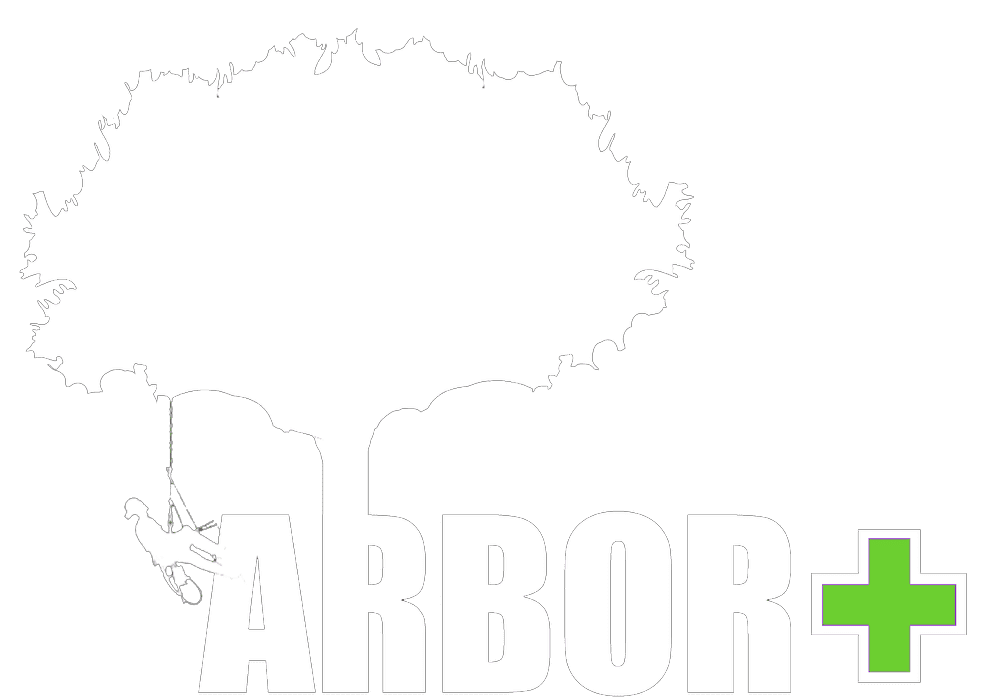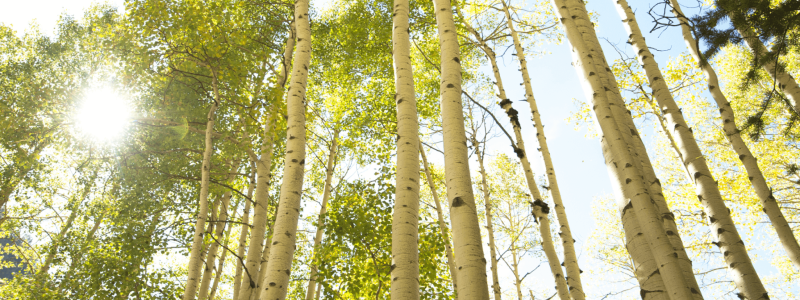Whether you’re looking for a single tree or an entire grove, understanding the unique characteristics of the aspen tree and how they thrive in Utah’s climate is essential. In the post below, we’ll explore topics such as soil quality, watering needs, pest management, and more that you should consider when deciding whether or not to invest in these beautiful trees and how the tree experts at Arborplus can help.
What are the different types of Aspen trees, and what are their unique features?
Aspen trees belong to the genus Populus in the Willow family, and are widely distributed across the northern hemisphere. Aspens are deciduous trees, meaning they lose their leaves every autumn.
There are three main types of Aspen trees:
- Quaking Aspen: A medium sized tree with thin, rounded leaves that flutter and quiver in the wind.
- Bigtooth Aspen: A large deciduous tree with broad oval shaped leaves and sharp teeth along the margins.
- Swedish Aspen: A tall column shaped tree with light colored bark and some of the best autumn color of any species, with gold being usual but also ranging through oranges and scarlet.
Aspens are known for their tall and slender trunks, which typically grow up to 50 to 80 feet (15–24 m) in height. The bark of an Aspen tree is smooth and white or gray in color, with dark diamond shapes that can appear on some trees. The leaves of the Aspen tree are small and round, with a silvery-green color.
Aspens prefer cooler climates and moist soils. They thrive in areas that experience several months of cold weather and plenty of snowfall during winter months. Aspens are also tolerant to drought conditions, making them a great choice for dryer climates.
Aspen trees are used for a variety of purposes, from providing shelter and shade to being made into wood products such as furniture and paper. They are also commonly used in landscaping projects due to their fast growth rate and attractive foliage.
Aspens are a key tree species for many ecosystems, and they are very important to the environment. They help protect soils from wind and water erosion, and they provide a source of food and shelter for wildlife.
Aspens are especially popular in Utah, where they are often found in forests and meadows. If you are looking to buy Aspen trees, make sure to research the best soil and climate conditions for your specific location. Doing so will help ensure that your Aspens thrive and remain healthy for years to come.
What are some key factors to consider when deciding whether to plant Aspen trees in your landscape?
When deciding to plant Aspen trees in your landscape, you need to consider a few things. First, make sure that the climate and soil conditions are suitable for this type of tree; they prefer plenty of sun, cooler climates, and moist, well-draining soil. You should also determine what purpose the trees will serve; Aspens can provide shelter and shade, as well as be used for wood products.
Research the best location for planting your Aspen trees. Protection from wind can be beneficial for young trees as they become established. It is also important to consider any potential planting restrictions from local ordinances before selecting your location. Don’t hesitate to contact Arborplus for help.
What are the best growing conditions for Aspen trees, and how can a homeowner provide them?
The best growing conditions for Aspen trees are cooler climates with plenty of moisture and snowfall during winter months. Aspens grow best in USDA Hardiness Zones 1-7. With average hardiness zones of 4-7, most of Utah is a welcoming home for Aspen trees.
Planting your trees in locations with full sun exposure (at least six hours per day), well-drained soil, some wind protection for young trees, and adequate rainfall will also help ensure the health of your Aspens.
What are some common pests and diseases that can affect Aspen trees, and how can you prevent or treat them?
Fungal pathogens such as rust, powdery mildew, and verticillium wilt are common threats to Aspen trees. Other pests like aphids, scale insects, sawflies, and borers can cause damage to Aspens as well. In order to prevent or treat these pests and diseases, you should regularly inspect your Aspen trees for signs of an infestation or disease symptoms.
If you do spot any problems with your tree’s health, it is important to take appropriate steps immediately in order to protect the tree from further damage. Removing affected leaves or branches is one way to reduce the spread of infection, while applying fungicides or insecticides may also be necessary in some cases. The professional arborists at Arborplus can help you take the necessary steps to protect your Aspen trees from pests and diseases and maintain their health.
How can a homeowner ensure that Aspen trees fit well with the existing landscaping and environment of your property?
Homeowners should select a tree species that is suitable for the climate, soil type, and natural environment. It is important to research the best planting location for your Aspens so that they receive adequate sunlight, at least six hours per day, and rainfall. Placing young trees in an area where there is some wind protection can also support optimal growth. It is also important to take measures to protect your Aspen trees from pests and diseases.
What are the benefits of Aspen trees beyond their aesthetics?
Aspens aren’t just another pretty tree! Beyond their lovely looks, Aspens provide shelter, shade, and wood products. They also offer food and refuge for birds, mammals, and insects. Aspen groves are important for maintaining healthy watersheds by reducing soil erosion. The presence of Aspens can also help improve air quality by reducing dust particles in the atmosphere. Mature Aspens act as a natural windbreak which helps protect other plants from strong gusts of wind.
What are some common mistakes to avoid when planting and caring for Aspen trees?
When planting and caring for Aspen trees, it is important to avoid some common mistakes. Overwatering is one of the most frequent causes of damage to Aspens since too much moisture can lead to root rot and other issues. To avoid overwatering, make sure your Aspens are planted in well-draining soil.
Allowing invasive species to take over your tree’s environment is another mistake that should be avoided as this could be detrimental to their health. Improper pruning can stunt the growth and development of your Aspens. Care should be taken when performing any maintenance on them.
Planting in an area with insufficient sunlight can hinder the growth and survival rate of your Aspen trees. Be sure to plant Aspens where they will receive full sun, at least six hours per day.
How can you properly prune and maintain Aspens for optimal growth and health?
For optimal growth and health of your Aspen trees, it is important to trim only the necessary branches. Doing this will help the tree keep its natural shape while still allowing for some selective pruning. Any dead or damaged branches should be removed from the tree as soon as possible in order to prevent spread of disease. It is also important to fertilize your Aspens every spring so that they receive the nutrients they need. Winter is generally the best time to trim Aspens as that is their dormant season. Always check for and remove any damaged limbs after heavy snowfalls. Protect your Aspens from harsh winter weather by providing them with adequate mulch and shelter.
What are some ways to incorporate Aspen trees into a sustainable and environmentally friendly landscape?
Planting Aspens in areas with poor soil conditions can help increase the fertility of the soil. Their fallen leaves create an excellent source of compost for other plants in the garden. Aspens also act as natural buffers to dust storms and are able to absorb large amounts of runoff water, which helps protect local watersheds.
Planting Aspens near roads or areas prone to strong winds will provide a natural windbreak that is beneficial for both human and animal life. Not only do these practices make your landscape more sustainable and eco-friendly, but they also make it more aesthetically pleasing!
How can you work with a professional arborist like Arborplus to select and plant Aspen trees that will thrive in your specific location?
When selecting and planting Aspens, it is important to work with an experienced professional arborist like Arborplus. We can provide valuable advice on the best varieties of Aspen trees for your specific climate and soil conditions.
Our tree experts are knowledgeable about proper planting methods that will help ensure success in your Utah landscape. Arborplus can provide ongoing maintenance and advice for optimal care of your Aspen trees over time. Contact us today for expert assistance selecting, planting, and caring for your Aspens so that they can best thrive in your location!

